The Canada Goose (Branta canadensis) is the familiar goose of parks and golf courses. In the spring and fall the loud honking of V-shaped migrating flocks overhead often draw the eyes of birders and non-birders alike. Unfortunately, its very ubiquitousness often makes it the target of ire.
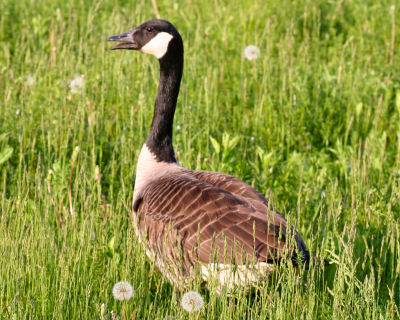
Canada Goose in a field at Five Rivers EEC, Delmar, NY
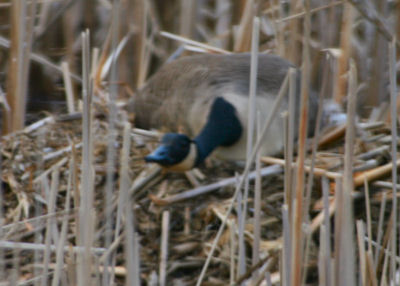
Canada Goose “hiding” on nest
The Canada Goose is difficult to confuse with other species, although some of the smaller subspecies might be confused with the recently split species, Cackling Goose. However, the Cackling Goose should be readily identifiable by its very short neck and shorter, stubbier bill. If in doubt, it’s a Canada Goose.
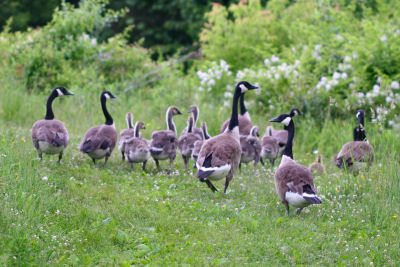
flock of temporarily flightless Canada Geese with goslings
Pairs of Canada Geese stake out a territory early in the spring and begin the construction of their nest. They will defend their nesting territory and young with vigor against other geese, animals, and people. Woe to the nonobservant walker who gets too close to the nest! A goose bite can really hurt, and if one flies at your head and buffets you with its wings you will not soon forget the experience!
Unlike the unfaithful drake Mallard, the male Canada Goose sticks around to help defend and watch over the young. This is why you often see a family of geese strung out single file, with a parent at each end.
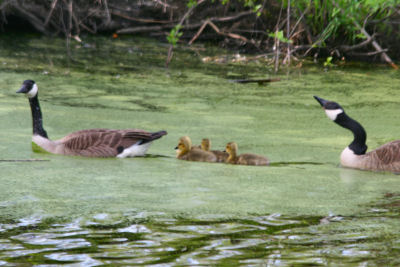
family of Canada Geese
Interestingly, Canada Geese molt all of their flight feathers at once, leaving them unable to fly and vulnerable to predation. This is probably why before humanity got involved they nested exclusively in the far north (less predators). However, even birds that breed in the southern portion of their range may leave their young with another family of geese and fly north to molt! Even when this behavior doesn’t occur several families of geese often conglomerate into a large flock while the birds are flightless, allowing more eyes to keep a lookout for danger. At Five Rivers every spring I enjoy watching these groups of geese wandering the paths, gobbling up green grass and preventing people from getting past (you try getting past a flock of geese with young present). And the goslings get so fat so fast!
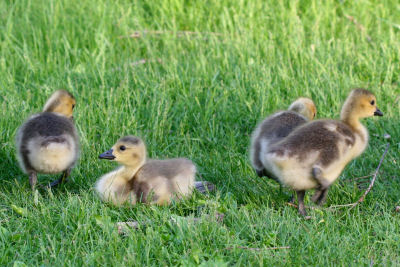
Canada Goose goslings at Five Rivers EEC, Delmar, NY
Locally, an overabundance of Canada Geese caused quite a controversy in the village of Scotia last summer when the village board proposed catching and gassing the geese, claiming that their (the geese’s, not the village board’s) droppings were polluting Collins Lake. Local residents and animal-rights activists rallied to the geese’s defense and the plan was prevented! It is somewhat ironic that geese that are only present in our area because of humanity’s short-sighted actions are now threatened by the power of small-minded people who can’t see past the goose-poop on the ground.
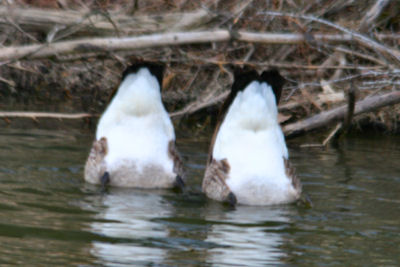
Here’s what we think of you, Scotia Village Board!
So when you next hear the wild honking of Canada Geese in migration over your head remember that when humans mess with nature the results are not always (and in fact, probably rarely) what was intended (rabbits in Australia anyone?).
And now for something completely different: my favorite YouTube video ever (not appropriate for children (though they probably hear worse on the school bus) or the workplace).













He’ll save children, but not the British children.
My husband rescued a baby canandian goose, the mother, father or other babies were no where to be found. She is 7 weeks or so old now and doing very well at my home, although we do not have a pond so she is in a kitty pool right now. I want what is best for her so should I just let her fly away if she chooses or take her to a near by pond where there are other geese? I don’t know how they will react to her since she has not been around them. Please inform me what is best…I will miss her if she ever leaves, but she should be with her own kind. Right now I am her mother I guess and she follows me around everywhere I go, which is cute but a pain when I am trying to work in my garden, LOL. Thank you for any information you can give to me. Sincerely Angel and Gurrdy (goose).
I am certainly no expert on wildlife rehab, but I imagine if Gurrdy gets the urge to go she will (and you should let her). Geese are very much creatures of habit, and I imagine that if Gurrdy migrates she will probably drop in for a visit (for a great tale of a goose doing just that read Bernd Heinrich’s “The Geese of Beaver Pond”).
I would recommend contacting your state’s department of fish and game (or the equivalent) or wildlife rehabbers in your area for better info than I can offer if Gurrdy doesn’t go on her own by late autumn.
Canadian Geese have been among us here in Co-op City, The Bronx since the 1980’s, and they have not left the area. They are here also during the winter months, which I find amazing! They graze in the grass honking, and leaving their doo droppings all around! However, they are a nice sight to see, and even hand feed them every once in awhile.
It is so hilarious to see them stop traffic when crossing a street, and how patiently people wait sometimes many minutes before it is safe to drive on. It is as if we were watching over their safety. Though, I do wonder if they are native to this area, or not? Does anyone have any information about their habitation in this area? Furthermore, we have a growing number of wildlife that wasn’t here during the 1970’s and 80’s like, Racoons, Skunks, and Possums. What next, Lions, Tigers, and Bears? Oh My!